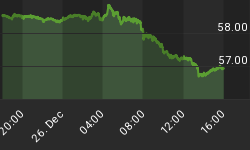But, All is Not Well
On January 6, 2006 the Secondary trend, according to Dow theory, was once again reconfirmed as bullish. Last week there were minor secondary non-confirmations forming and this week those minor non-confirmations were corrected as both averages moved yet again above the most recent Secondary high points. As a result, the Secondary Trend has been reconfirmed as positive. In order to turn the Secondary Trend negative, it will take a joint move by both averages below their previous Secondary low points.

In the next chart below we have the Industrials verses the Dow Jones Top Ten Index. The Top Ten Index is a subset of the Industrials and is comprised of the top 10 dividend yielding stocks within the Industrials. Here, we find a non-confirmation that has been going on now for over a year. The fact that this index is not confirming the Industrials is cause for concern as this is an important non-confirmation that is occurring from within the Dow 30. Since the Top Ten is a subset of the Industrials, we should indeed be seeing it confirm the movement of the Industrials themselves. With a third of the larger index lagging, this failure can only be viewed as an unhealthy sign. On a percentage basis, the move out of the October Secondary low by the Top Ten has been a greater move than that of the Industrials, but with regard to price structure, the divergence or non-confirmation is obvious.

In fact, the last time such non-confirmation occurred was in connection with the 2000 top. That non-confirmation is shown on the chart below and we all remember what followed where this chart leaves off.

In the next chart below we have the Industrials verses the Nasdaq 100. Here, both indexes have held above the recent support levels as is noted in green. However, the fact that the Nasdaq is lagging is troublesome.

In fact, the last two intermediate term tops have occurred with just such non-confirmations between these two averages in place. These non-confirmations are marked in blue on the chart below and you can clearly see that we have the same such non-confirmation occurring now. Should the Nasdaq 100 fail to hold this support level, then it should mark the beginning of the end for this intermediate term cycle advance. Should the Nasdaq 100 better its January high, then this non-confirmation will be mended, all four of these averages would be in gear with each other and new recovery highs would be one giant step closer to reality.

Also in regard to the Nasdaq, when we look beneath the surface, the internals stink. As an example, I have plotted a chart of the Nasdaq 100 below. In the upper window I have plotted a measure of Advancing Nasdaq Issues in green and Declining Nasdaq Issues in red. Note that the intermediate-term advance into the December 2004 high peaked with diverging advancing issues and increasing declining issues. The same is also true for the August 2005 intermediate-term cycle top and we are seeing this same pattern occurring once again at present levels.

When we back up even further we find that every single intermediate-term advance since the first leg up out of the 2002 low has occurred on progressively lower advancing issues. This is telling us this advance has been liquidity driven and not supported by strong internals with real buying. No advance can continue with continuously weakening internals.

In fact, the last time such non-confirmation between price and the Nasdaq advancing issues occurred was in connection with the 2000 bull market top.

The bottom line here is that yes, the Secondary Trend according to Dow theory remains bullish, while the Primary Trend remains bearish. The Dow theory phasing continues to suggest that there is more downside on a larger scale yet to come. The fact that we are seeing non-confirmations between other indexes serves as warnings that simply cannot be ignored. In the meantime, the Secondary Trend remains positive. If you would like more specifics on this Advance/Decline data, cycles, the statistical probabilities for 2006, Dow theory phasing, expected turn points, access to the Cycle Turn Indicator to pin point these turn points and much much more, then please visit www.cyclesman.com for subscription information. I cover the stock market, gold, the dollar and bonds. The newsletter also includes short-term update 3 nights a week.
















